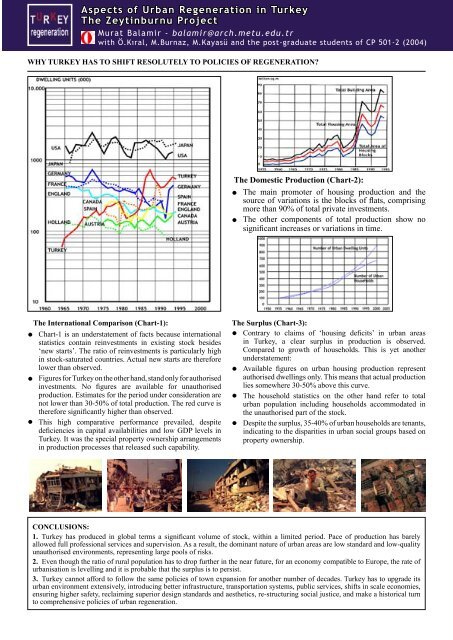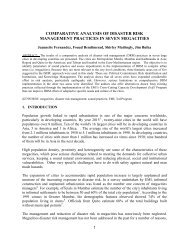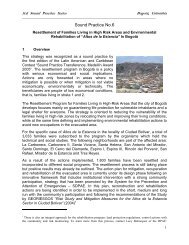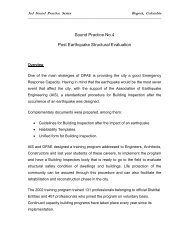Aspects of Urban Regeneration in Turkey The Zeytinburnu Project
Aspects of Urban Regeneration in Turkey The Zeytinburnu Project
Aspects of Urban Regeneration in Turkey The Zeytinburnu Project
Create successful ePaper yourself
Turn your PDF publications into a flip-book with our unique Google optimized e-Paper software.
<strong>Aspects</strong> <strong>of</strong> <strong>Urban</strong> <strong>Regeneration</strong> <strong>in</strong> <strong>Turkey</strong><strong>The</strong> Zeyt<strong>in</strong>burnu <strong>Project</strong>Murat Balamir - balamir@arch.metu.edu.trwith Ö.Kıral, M.Burnaz, M.Kayasü and the post-graduate students <strong>of</strong> CP 501-2 (2004)WHY TURKEY HAS TO SHIFT RESOLUTELY TO POLICIES OF REGENERATION?<strong>The</strong> Domestic Production (Chart-2):<strong>The</strong> ma<strong>in</strong> promoter <strong>of</strong> hous<strong>in</strong>g production and thesource <strong>of</strong> variations is the blocks <strong>of</strong> flats, compris<strong>in</strong>gmore than 90% <strong>of</strong> total private <strong>in</strong>vestments.<strong>The</strong> other components <strong>of</strong> total production show nosignificant <strong>in</strong>creases or variations <strong>in</strong> time.<strong>The</strong> International Comparison (Chart-1):Chart-1 is an understatement <strong>of</strong> facts because <strong>in</strong>ternationalstatistics conta<strong>in</strong> re<strong>in</strong>vestments <strong>in</strong> exist<strong>in</strong>g stock besides‘new starts’. <strong>The</strong> ratio <strong>of</strong> re<strong>in</strong>vestments is particularly high<strong>in</strong> stock-saturated countries. Actual new starts are thereforelower than observed.Figures for <strong>Turkey</strong> on the other hand, stand only for authorised<strong>in</strong>vestments. No figures are available for unauthorisedproduction. Estimates for the period under consideration arenot lower than 30-50% <strong>of</strong> total production. <strong>The</strong> red curve istherefore significantly higher than observed.This high comparative performance prevailed, despitedeficiencies <strong>in</strong> capital availabilities and low GDP levels <strong>in</strong><strong>Turkey</strong>. It was the special property ownership arrangements<strong>in</strong> production processes that released such capability.<strong>The</strong> Surplus (Chart-3):Contrary to claims <strong>of</strong> ‘hous<strong>in</strong>g deficits’ <strong>in</strong> urban areas<strong>in</strong> <strong>Turkey</strong>, a clear surplus <strong>in</strong> production is observed.Compared to growth <strong>of</strong> households. This is yet anotherunderstatement:Available figures on urban hous<strong>in</strong>g production representauthorised dwell<strong>in</strong>gs only. This means that actual productionlies somewhere 30-50% above this curve.<strong>The</strong> household statistics on the other hand refer to totalurban population <strong>in</strong>clud<strong>in</strong>g households accommodated <strong>in</strong>the unauthorised part <strong>of</strong> the stock.Despite the surplus, 35-40% <strong>of</strong> urban households are tenants,<strong>in</strong>dicat<strong>in</strong>g to the disparities <strong>in</strong> urban social groups based onproperty ownership.CONCLUSIONS:1. <strong>Turkey</strong> has produced <strong>in</strong> global terms a significant volume <strong>of</strong> stock, with<strong>in</strong> a limited period. Pace <strong>of</strong> production has barelyallowed full pr<strong>of</strong>essional services and supervision. As a result, the dom<strong>in</strong>ant nature <strong>of</strong> urban areas are low standard and low-qualityunauthorised environments, represent<strong>in</strong>g large pools <strong>of</strong> risks.2. Even though the ratio <strong>of</strong> rural population has to drop further <strong>in</strong> the near future, for an economy compatible to Europe, the rate <strong>of</strong>urbanisation is levell<strong>in</strong>g and it is probable that the surplus is to persist.3. <strong>Turkey</strong> cannot afford to follow the same policies <strong>of</strong> town expansion for another number <strong>of</strong> decades. <strong>Turkey</strong> has to upgrade itsurban environment extensively, <strong>in</strong>troduc<strong>in</strong>g better <strong>in</strong>frastructure, transportation systems, public services, shifts <strong>in</strong> scale economies,ensur<strong>in</strong>g higher safety, reclaim<strong>in</strong>g superior design standards and aesthetics, re-structur<strong>in</strong>g social justice, and make a historical turnto comprehensive policies <strong>of</strong> urban regeneration.
IN WHAT WAYS THE NEED FOR URBAN REGENERATION IS CURRENTLY PERCEIVED IN TURKEY?<strong>Urban</strong> regeneration has recently beena central issue <strong>of</strong> consideration, andattempts to regulate this process havemultiplied <strong>in</strong> <strong>Turkey</strong>. This may be dueto risks <strong>in</strong>volved, or aspirations <strong>of</strong>appropriat<strong>in</strong>g rents <strong>in</strong>volved, or simplyfor the sake <strong>of</strong> appearances. <strong>The</strong>reis no uniform undestand<strong>in</strong>g <strong>of</strong> whatregeneration is.<strong>The</strong> Law <strong>of</strong> ‘GreatercityMunicipalities’ (5216; 2004):Prerogatives given to these authorities<strong>in</strong>clude the preparation <strong>of</strong> ‘StrategicPlans’ which are essentially socioeconomic<strong>in</strong> nature, besides physical(article 7a). ‘environmental plans’(7b), and plans concern<strong>in</strong>g disasters(7u). Powers to ‘vacate and demolishdangerous build<strong>in</strong>gs, and to ‘demolish allother non-conform<strong>in</strong>g structures’ (7z) arevested with these municipalities. <strong>The</strong>yare capable <strong>of</strong> <strong>in</strong>stitut<strong>in</strong>g partnershipswith local municipalities and privatefirms, or establish<strong>in</strong>g firms themselves.<strong>The</strong>y can participate <strong>in</strong> services andcosts <strong>of</strong> projects carried out with public,private bodies or NGOs (24n), nationalor <strong>in</strong>ternational. <strong>The</strong>se municipalitiesare also entitled to <strong>in</strong>stitute ‘f<strong>in</strong>ancialorganizations’, and to undertake manyforms <strong>of</strong> partnerships <strong>in</strong> comprehensiveregeneration projects (26).<strong>The</strong> Law <strong>of</strong> Municipalities (5215;2004):Municipalities are responsible forprotect<strong>in</strong>g natural, historical andcultural assets <strong>in</strong> their functions <strong>of</strong> planpreparation. <strong>The</strong>y can exercise powers<strong>of</strong> compulsory purchase for this purposeand for hous<strong>in</strong>g provision; start firms,borrow capital, issue shares and paperassets (68). Municipalities <strong>of</strong> 50 000 andabove can designate areas (not smallerthan 50 000 m 2 ) for ‘urban regenerationand development projects’ and riskreduction (73). Processes <strong>of</strong> demolish<strong>in</strong>gor alter<strong>in</strong>g exist<strong>in</strong>g build<strong>in</strong>gs under thispretext are subject only to 0.25 <strong>of</strong> regularduties. Voluntary agreements withproperty owners are the preferred method<strong>in</strong> regeneration projects. This doesnot however exclude the prerogatives<strong>of</strong> exercis<strong>in</strong>g compulsory purchase.Disagreements have priority to othercases <strong>in</strong> the courts.<strong>The</strong> Law Concern<strong>in</strong>g the NorthernEntry to Ankara (5104; 2004)This special Law aims to improve theappearances and ‘life standards’ <strong>of</strong> adel<strong>in</strong>eated project area. <strong>The</strong> GreaterMunicipality <strong>of</strong> Ankara is responsible forthe preparation <strong>of</strong> a plan (1/5000), subjectto the approval <strong>of</strong> the M<strong>in</strong>istry. Allpublic and private property is subject tocompulsory purchase. This is preferablycarried out with mutual agreementsbetween property owners and theMunicipality. An <strong>in</strong>ventory <strong>of</strong> propertyowners entitled to specific shares <strong>in</strong>prospective property is to record the size,development type, and the legal status <strong>of</strong>current property. This provides optionsfor <strong>in</strong>dividuals (tenants <strong>in</strong>cluded), anddescribes a programme <strong>of</strong> payments, thevalue <strong>of</strong> the exist<strong>in</strong>g property deducedfrom total debt. <strong>The</strong> non-conform<strong>in</strong>gproperty owners are subject to the specialprocedures <strong>of</strong> the Compulsory PurchaseLaw (2942, article 3), empower<strong>in</strong>g themunicipality to distribute payments upto 5 years. <strong>The</strong> Greater Municipality<strong>of</strong> Ankara is entitled to have access tocredits <strong>of</strong> the Hous<strong>in</strong>g Adm<strong>in</strong>istration.<strong>The</strong> Draft Development Law:<strong>The</strong> <strong>in</strong>tended Law empowers themunicipalities <strong>in</strong> the designation <strong>of</strong>several types <strong>of</strong> special plann<strong>in</strong>g areasfor the purposes <strong>of</strong> implement<strong>in</strong>g projectsconcern<strong>in</strong>g protection, regeneration,<strong>in</strong>tensive development, and public and/orprivate <strong>in</strong>vestments. Municipalities areobliged to carry out mitigation plansto reduce disaster risks, if ignored, theM<strong>in</strong>istry could use its prerogatives. <strong>The</strong>yare entitled to determ<strong>in</strong>e the location andsize <strong>of</strong> areas for such operations, prepareplans and projects. <strong>The</strong> municipality orthe majority <strong>of</strong> the property owners <strong>in</strong>an area could form partnerships for theredevelopment and/or jo<strong>in</strong>t management<strong>of</strong> the area. Besides physical operations <strong>of</strong>clearance, development, protection, suchprojects are envisaged to cover policies<strong>of</strong> f<strong>in</strong>ance, management, ownership andmeans <strong>of</strong> socio-economic development.<strong>The</strong> tools for such operations aredeterm<strong>in</strong>ed by the municipalities, whichare entitled to 30% <strong>of</strong> the property valuesand 25% <strong>of</strong> build<strong>in</strong>g surface <strong>in</strong>creasesgenerated. “Protect<strong>in</strong>g the rights <strong>of</strong>the orig<strong>in</strong>al owners, the municipalities<strong>in</strong> these areas could carry out leaseagreements, servitudes, comprehensiveproject development, tender<strong>in</strong>g forconstruction, supervision, arrang<strong>in</strong>gshares accord<strong>in</strong>g to the Flat OwnershipLaw, management organizations, etc....and demolish exist<strong>in</strong>g build<strong>in</strong>gs avoid<strong>in</strong>gpublic purchase” Such property will beexempt from sales and purchase taxes for5 years, and VAT will be applicable at therate <strong>of</strong> 1%.<strong>The</strong> Draft Law <strong>of</strong> <strong>Urban</strong> <strong>Regeneration</strong>and Development:Still another draft law is currently underreview <strong>in</strong> the Parliamentary Committee.This has almost identical word<strong>in</strong>g withthe Law <strong>of</strong> Municipalities, reduc<strong>in</strong>g onlythe regeneration area to 10 000 m 2 , andallow<strong>in</strong>g a phased implementation. <strong>The</strong>draft law provides absolute powers to themunicipalities not only <strong>in</strong> the preparation<strong>of</strong> plans and projects, but also <strong>in</strong> theappropriation <strong>of</strong> all property, and thearrangement <strong>of</strong> rights <strong>of</strong> developmentand use, even <strong>in</strong> the cases <strong>of</strong> absenteeownership.Action Preferred by the MetropolitanMunicipality <strong>of</strong> Istanbul (MMI):Disturbed by the earthquake lossassessments, the MMI <strong>in</strong>tends to carry outsurveys <strong>of</strong> the exist<strong>in</strong>g stock, identify<strong>in</strong>gbuild<strong>in</strong>gs dest<strong>in</strong>ed to collapse. <strong>The</strong>residents <strong>of</strong> such build<strong>in</strong>gs will be eligiblefor the option <strong>of</strong> own<strong>in</strong>g a new ‘safe andhigh quality’ dwell<strong>in</strong>g elsewhere <strong>in</strong> thenew development areas <strong>of</strong> metropolitanIstanbul. <strong>The</strong>se households will then beliable to pay back a long-term (20-30years) credit debt. Concurrently, MMIis to undertake a build<strong>in</strong>g programmewith resources provided by the Hous<strong>in</strong>gAdm<strong>in</strong>istration <strong>of</strong> <strong>Turkey</strong>. Distributedto various subdistricts <strong>in</strong> groups, it isclaimed that pilot implementationstotal<strong>in</strong>g twenty thousand dwell<strong>in</strong>g unitswill be completed <strong>in</strong> two years. Thisis said to correspond to an <strong>in</strong>vestmentprogramme <strong>of</strong> 2 billion US Dollars.Po<strong>in</strong>t<strong>in</strong>g to the fact that 70% <strong>of</strong> theIstanbul stock <strong>of</strong> one million build<strong>in</strong>gsis unauthorised, the Mayor demandedfree access to Treasury lands <strong>in</strong> order toaccomplish the total ‘survival project’.Although there are multiple attempts toregulate urban regeneration processes<strong>in</strong> <strong>Turkey</strong>, there is little real worldexperience or f<strong>in</strong>ely detailed projectsbased on authentic circumstances.One exception has been the case <strong>of</strong>Zeyt<strong>in</strong>burnu, a most vulnerable district<strong>in</strong> Istanbul <strong>in</strong> the face <strong>of</strong> the impend<strong>in</strong>gearthquake.
COMPREHENSIVE REGENERATION IN THE VULNERABLE DISTRICT OF ZEYTINBURNU, ISTANBUL<strong>The</strong> District-Level Prospects as a Basisfor <strong>Regeneration</strong>Located at the centre <strong>of</strong> Istanbul andclose to the fault-l<strong>in</strong>e, Zeyt<strong>in</strong>burnuhas a number <strong>of</strong> major potential sitesand development prospects at themetropolitan scale. <strong>The</strong>se will havedirect impact on the regeneration <strong>of</strong> thedistrict, and plans will have to base theirstrategies on their shap<strong>in</strong>g. Large tracks<strong>of</strong> land available at two dist<strong>in</strong>ct po<strong>in</strong>ts<strong>in</strong> the area constitute a rare opportunityat the metropolitan level. <strong>The</strong> fate <strong>of</strong>these areas is not unpredictable as manydecisions are already made. However thesheer size <strong>of</strong> these <strong>in</strong>vestments demandscareful plann<strong>in</strong>g and procurement,<strong>in</strong>volvement <strong>of</strong> <strong>in</strong>vestors from abroad,and competitive mechanisms <strong>in</strong> theirdesign and development. It is essential toclarify the macro-level scenarios, prior tothe monitor<strong>in</strong>g <strong>of</strong> regeneration operationsat the level <strong>of</strong> local communities.Nodes and the Sp<strong>in</strong>e:1. <strong>The</strong> METROGAR complex is verylikely to take place on vacant land South<strong>of</strong> the railway, as the term<strong>in</strong>al po<strong>in</strong>t <strong>of</strong>the Trans-European Rapid tra<strong>in</strong> (TER),and the surfac<strong>in</strong>g po<strong>in</strong>t <strong>of</strong> the Marmarail.This prospect is to transform the area<strong>in</strong>to a most prom<strong>in</strong>ent node <strong>of</strong> Istanbulwhere all metropolitan, regional and<strong>in</strong>ternational l<strong>in</strong>ks <strong>of</strong> rail, sea, landtransportation modes and routes willconverge. This immense potential isto prove very high rates <strong>of</strong> return, anddeserves special projects exploit<strong>in</strong>g<strong>in</strong>ternational <strong>in</strong>vestment capacities<strong>in</strong> transport and tourism facilities,commercial, <strong>of</strong>fices, etc., where up to10 million m 2 <strong>of</strong> build<strong>in</strong>g floor area canbe estimated to agglomerate. Specialorganizational skills are necessary tomonitor this attractive <strong>in</strong>vestment area, <strong>in</strong>the form <strong>of</strong> Consortiums or REITs led bythe Metropolitan Municipality. Plann<strong>in</strong>gand design <strong>of</strong> the area could largely becarried out by national and <strong>in</strong>ternationalcompetitions.2. <strong>The</strong> Northern Development Area(METROMOD) consists <strong>of</strong> twoneighbour<strong>in</strong>g large sites availablefor <strong>in</strong>tensive development on the E5motorway, and represents a uniqueopportunity. <strong>The</strong> area can be developed asa multi-purpose complex, an outlet centerfor leather and textiles <strong>in</strong>dustries backedby a techno-park, R&D and <strong>in</strong>formationcenter, design and fashion center,<strong>in</strong>tegrated with tra<strong>in</strong><strong>in</strong>g, workshops,and congress centre, exhibition, fair,show-rooms, hotels, <strong>of</strong>fice complexes<strong>of</strong> corporate firms etc. to up-gear the<strong>in</strong>dustrial sectors <strong>of</strong> Zeyt<strong>in</strong>burnu. Majorshopp<strong>in</strong>g and outlet centers next tothe motorway could complement thiscomplex lead<strong>in</strong>g to an agglomeration<strong>of</strong> almost 8 million m 2 . This justifiesan <strong>in</strong>vestment strategy to mobilisemost <strong>of</strong> the Zeyt<strong>in</strong>burnu <strong>in</strong>dustrial andcommercial capital, <strong>in</strong>corporat<strong>in</strong>g boththe Commercial and Industrial Chambers<strong>of</strong> Istanbul.3. Zeyt<strong>in</strong>burnu URBAN SPINE is likelyto develop between these two attractionnodes (1200m.) even if not envisaged byany plan. Intensive demand on this axiswill favor mixed uses at high densities.Development Partnerships can operate<strong>in</strong> this area, provid<strong>in</strong>g shares to exist<strong>in</strong>gproperty owners, the municipality,community partnerships, and otherright holders. A central pedestrian axis,a promenade, plazas, open and greenpublic spaces could mark the ma<strong>in</strong>Sp<strong>in</strong>e, accessible by public transportstations, and underground carparks.Such public <strong>in</strong>vestments will justify<strong>in</strong>creased densities and partnership <strong>of</strong>the Municipality. <strong>The</strong> Develoment Plancould be revised here to <strong>in</strong>dicate thenew rights <strong>of</strong> development <strong>in</strong> the case<strong>of</strong> unified build<strong>in</strong>g plots, encourag<strong>in</strong>gproperty owners to form Partnerships,entitl<strong>in</strong>g them to higher densities ifthey do <strong>in</strong>corporate transferred rights <strong>of</strong>development.Fault l<strong>in</strong>es under seaZEYTİNBURNUSpecial Policy Areas <strong>in</strong> Zeyt<strong>in</strong>burnuOther than the Nodes and the Sp<strong>in</strong>e,Zeyt<strong>in</strong>burnu district has a number <strong>of</strong>special areas that require dist<strong>in</strong>ct spatialpolicies. <strong>The</strong>se are the Water-Front, theWall-Front Tourism Band, the High RiskÇırpıcı Valley-Front, the E-5 ChannelBands, and the Industrial Zone, eachdemand<strong>in</strong>g special <strong>in</strong>centives.Local Community Partnerships(Super-Blocks):<strong>Regeneration</strong> processes <strong>in</strong> the residentialstock will be under the physical andeconomic pressures <strong>of</strong> macro leveltendencies and policy changes <strong>in</strong> thearea. <strong>The</strong> property owners <strong>in</strong> this contextwill be encouraged for local cooperationand partnerships <strong>in</strong> self-f<strong>in</strong>anc<strong>in</strong>gredevelopment schemes. <strong>The</strong> overallmonitor<strong>in</strong>g will take place by revisions <strong>in</strong>the Development Plan, the Municipalityidentify<strong>in</strong>g the Super-Blocks (<strong>of</strong> about1000 households) for the purpose. <strong>The</strong>partnership <strong>in</strong> the Super-Block is notnecessarily different from the familiarflat-ownership management practices<strong>in</strong> <strong>in</strong>dividual build<strong>in</strong>gs. <strong>The</strong> details <strong>of</strong>the local regeneration model based onpartnerships are described below.Hierarchy <strong>of</strong> Interrelated Rent-Generat<strong>in</strong>gand Transferr<strong>in</strong>g Mechanisms:One <strong>of</strong> the major objectives <strong>of</strong>regeneration operation <strong>in</strong> the district isto <strong>in</strong>volve all real and legal persons <strong>in</strong>the formation and management <strong>of</strong> assets<strong>in</strong> the area. Community Partnerships willbe eligible for shares (however small)<strong>in</strong> the rent generat<strong>in</strong>g <strong>Urban</strong> Sp<strong>in</strong>eand Consortiums, alongside with theMunicipality, land owners and <strong>in</strong>vestors.
ZEYTINBURNU SUB - PROVINCE ISTANBULPrepared for the UK-<strong>Turkey</strong> <strong>Urban</strong> <strong>Regeneration</strong> Symposium, 22 March 2005 Ankara500 pr<strong>in</strong>ted at Ünal Ofset.
COMPREHENSIVE REGENERATION IN ZEYTINBURNU BY MEANS OF COMMUNITY PARTNERSHIPS<strong>The</strong> purpose <strong>of</strong> this project is to demonstratethat comprehensive regeneration could proveviable <strong>in</strong> physical, economic and socialterms, even under most adverse conditions.Zeyt<strong>in</strong>burnu has comparative advantages<strong>in</strong> comprehensive regeneration with<strong>in</strong>the metropolitan context. Unique localopportunities exist to capitalize and generatean impetus for total physical change androbust development.<strong>The</strong> Need for Comprehensive<strong>Regeneration</strong> <strong>in</strong> the Residential Areas <strong>of</strong>Zeyt<strong>in</strong>burnu<strong>The</strong> dom<strong>in</strong>ant form <strong>of</strong> development <strong>in</strong>Zeyt<strong>in</strong>burnu is unauthorized blocks <strong>of</strong> flatson <strong>in</strong>formally subdivided land. Althoughall technical and eng<strong>in</strong>eer<strong>in</strong>g services wereavoided at their <strong>in</strong>ception, a m<strong>in</strong>or part <strong>of</strong>this stock experienced legal registration after1984. This does not however make them anysafer. <strong>The</strong> urban texture characteristics arenarrow and irregular roads, complete coverage<strong>in</strong> plots, small frontage, 4-5 storey high blockswith high proportion <strong>of</strong> circulation spaces <strong>in</strong>the build<strong>in</strong>gs. This represents not only awaste <strong>of</strong> space, but also a large pool <strong>of</strong> risks.When EQ strikes, risks are consistently veryhigh irrespective <strong>of</strong> whether one is with<strong>in</strong>the build<strong>in</strong>gs or out <strong>in</strong> the street. This is thefundamental reason for a comprehensiveregeneration, rather than a retr<strong>of</strong>itt<strong>in</strong>g policyconf<strong>in</strong>ed to s<strong>in</strong>gular build<strong>in</strong>gs. Retr<strong>of</strong>itt<strong>in</strong>g <strong>of</strong>the unauthorized stock is legally and sociallynot viable. Another reason for comprehensiveregeneration is the <strong>in</strong>tense need for social andeconomic promotion <strong>of</strong> households, and theenhancement <strong>of</strong> community life, collectiveactivities and spaces. It is essential to improvelife standards, <strong>in</strong>troduce variety <strong>in</strong> economicsectors and employment, and <strong>in</strong>duce social<strong>in</strong>tegration <strong>in</strong> Zeyt<strong>in</strong>burnu, besides physicalredevelopment. A comprehensive regenerationapproach will not only discard the idea <strong>of</strong>piecemeal retr<strong>of</strong>itt<strong>in</strong>g operations but also<strong>in</strong>validate partial attempts as widen<strong>in</strong>g <strong>of</strong>‘evacuation boulevards’.<strong>The</strong> Scope <strong>of</strong> <strong>Regeneration</strong>1. Integration <strong>of</strong> the recommendations <strong>of</strong>the EQ Mitigation Plan for Istanbul (EMPI)and the measures envisaged <strong>in</strong> the subprov<strong>in</strong>cegovernorate Emergency Plan <strong>in</strong> thepreparation <strong>of</strong> an overall Master Plan;2. Assessment <strong>of</strong> likely <strong>in</strong>vestmentsand developments <strong>in</strong> the near future <strong>in</strong>Zeyt<strong>in</strong>burnu, and exploit<strong>in</strong>g such tendenciesto speed up regeneration processes;3. Methods and tools to attract propertyowners and other stake-holders <strong>in</strong> Partnershipsfor cooperat<strong>in</strong>g <strong>in</strong> local and macro-levelphysical and social improvements <strong>in</strong> the area;4. Engagement <strong>of</strong> <strong>in</strong>terest, participation andcontributions <strong>of</strong> local communities <strong>in</strong> theprocess, through regular <strong>in</strong>formation systems;employment <strong>of</strong> residents <strong>in</strong> regenerationactivities, and <strong>in</strong> special social projects toupgrade employment, <strong>in</strong>comes, and liv<strong>in</strong>gstandards, devised particularly for the low<strong>in</strong>come groups <strong>in</strong> Zeyt<strong>in</strong>burnu.5. Preparation <strong>of</strong> an explicit ‘organisationalprocedures road-map’ to identify stake-holdersand responsibilities <strong>in</strong> the coord<strong>in</strong>ation <strong>of</strong>Consortiums, Development Corporations andlocal Community Partnerships.Targets and Pr<strong>in</strong>ciples1. Residents as owner occupiers and tenantswill not be forced out from their habitats,unless hazard characteristics dictate otherwise;Gentrification will be avoided;241 Build<strong>in</strong>gs990 Dwell<strong>in</strong>gsPLOTCOVERAGEBUILDINGDENSITY4500 PersonsExist<strong>in</strong>g Densities2. No free external resources, subsidies orgrants will be assumed available; Rather,as self-f<strong>in</strong>anc<strong>in</strong>g schemes, it is the propertyowners’ own economic capacities andlong-term credit and debt programmescoord<strong>in</strong>ated under Community Partnerships,that comprehensive regeneration will f<strong>in</strong>d itsresources;3. This is a ‘campaign management’ projectto create a climate <strong>of</strong> total mobilization,<strong>in</strong>volv<strong>in</strong>g each and every <strong>in</strong>dividual andgroup <strong>of</strong> the community <strong>in</strong> mitigation efforts;4. Through the Community Partnerships,property owners will become share-holders <strong>in</strong>the Development Corporations, Consortiums,<strong>Urban</strong> Sp<strong>in</strong>e enterprises, and other <strong>in</strong>comegenerat<strong>in</strong>g bodies <strong>in</strong> Zeyt<strong>in</strong>burnu;5. <strong>The</strong> redevelopment will lead to highersafety and quality <strong>in</strong> urban environments;to social organisations that allow collectivemanagement <strong>of</strong> larger urban areas, anda new representation system <strong>in</strong> the cityadm<strong>in</strong>istration;6. <strong>The</strong> model devised here with its physical,organizational, f<strong>in</strong>ancial and legal apparatuswill be replicable <strong>in</strong> other areas <strong>in</strong> Istanbuland <strong>Turkey</strong>.
Spatial and Physical <strong>Aspects</strong>Economics and F<strong>in</strong>anceBuild<strong>in</strong>g Development PreferencesA <strong>Regeneration</strong> Model Based on LocalPartnershipsAn outly<strong>in</strong>g feature <strong>of</strong> the model describedhere is the role <strong>of</strong> Municipality <strong>in</strong> activat<strong>in</strong>gand enabl<strong>in</strong>g local communities to startpartnerships for the redevelopment andmanagement <strong>of</strong> Super-blocks (<strong>of</strong> about 1000dwell<strong>in</strong>gs). Programs will be conductedto attract and <strong>in</strong>form households about theobligations, advantages and procedures <strong>of</strong>participation. Such campaigns will employas many residents from the area as possible.Special programs will be organised fora small group <strong>of</strong> authentically poor andhandicapped households. <strong>The</strong> nature <strong>of</strong> thisparticipation is not any different from thewidely practiced ‘flat-ownership’ procedures.Households will undertake <strong>in</strong>dividual creditdebt programs organised by the Partnershipand the Municipality, <strong>in</strong> return for rights toredeveloped property and a bundle <strong>of</strong> otherrights.Redevelopment and Physical DesignOptionsMany alternative site plans and urbandesigns could be devised when a scope forcomprehensive renewal arises as propertyis unified through Community Partnerships.<strong>The</strong> <strong>in</strong>vestigation here considered a densely(3.5) packed area (plot coverage 0.80), andquestioned if methods are available forredevelopment, and if densities could befurther <strong>in</strong>creased to fulfil specific objectives:as protect<strong>in</strong>g the tenants and avoid<strong>in</strong>ggentrification <strong>in</strong> the area, m<strong>in</strong>imiz<strong>in</strong>grunn<strong>in</strong>g costs, accommodat<strong>in</strong>g all carsunderground, or compensat<strong>in</strong>g some ratio <strong>of</strong>the debt programmes. Even <strong>in</strong> such packedareas it is observed that 15-20% <strong>in</strong>crease <strong>in</strong>build<strong>in</strong>g densities are feasible due to spaceeconomies <strong>of</strong> unification without concessionsfrom urban space standards. A second set<strong>of</strong> considerations dealt with the shap<strong>in</strong>g<strong>of</strong> build<strong>in</strong>gs. Tunnel-frame construction,symmetrical designs, lower<strong>in</strong>g centre <strong>of</strong>gravity, pyramidal sections <strong>in</strong> monolithicbodies with high rates <strong>of</strong> concrete curta<strong>in</strong>walls <strong>in</strong> either axes avoid<strong>in</strong>g lifts werepreferred for higher safety and relativelylower construction costs. Such preferencesalso promise alternative aesthetics, designsolutions and some capacity to change urbanidentity <strong>in</strong> the city. This unification promisesa reward<strong>in</strong>g area <strong>of</strong> pr<strong>of</strong>essional practice forarchitects and urban designers.Economics and F<strong>in</strong>ances <strong>of</strong> <strong>Regeneration</strong>Two voluntary constra<strong>in</strong>ts are imposed here.<strong>The</strong> operation is a self-f<strong>in</strong>anc<strong>in</strong>g project, andno <strong>in</strong>cidental external resources are deemedessential for regeneration. If such resources areavailable, these would only act as a bonus tomake regeneration more attractive. Secondly,the deal will <strong>of</strong>fer no build<strong>in</strong>g area <strong>in</strong> returnfor the services <strong>of</strong> a developer, but a normalrate <strong>of</strong> pr<strong>of</strong>it, contrary to the conventions <strong>in</strong><strong>Turkey</strong>. This is to avoid gentrification. Onthe other hand, two f<strong>in</strong>ancial and proceduralburdens <strong>of</strong>ten confronted <strong>in</strong> regenerationprojects are avoided here. No ‘compulsorypurchase’ is necessary s<strong>in</strong>ce this is a voluntaryproperty development partnership, andan extensively-practiced easement <strong>in</strong> theconstruction <strong>of</strong> s<strong>in</strong>gle blocks <strong>of</strong> flats willsuffice. Secondly, the task <strong>of</strong> ‘current valuesassessments’ is avoided. <strong>The</strong> operation herewill only have to take <strong>in</strong>to account the exist<strong>in</strong>gdeed shares and recalculate them <strong>in</strong> terms <strong>of</strong>new totals. This will be the basis for newrights subject to m<strong>in</strong>or corrections accord<strong>in</strong>gto the ‘as built’.<strong>The</strong> total costs <strong>of</strong> development is to <strong>in</strong>cludethe developers’ average pr<strong>of</strong>it rates anddisturbance costs <strong>of</strong> the residents. <strong>The</strong>se will bemet by the <strong>in</strong>dividual credit debt programmes.It is most likely therefore that costs <strong>of</strong>temporary accommodation will be m<strong>in</strong>imized,<strong>in</strong>dividuals exploit<strong>in</strong>g their own means to theend. <strong>The</strong> mass removal <strong>of</strong> residents and <strong>of</strong>their household items could well be organisedby the Municipality to reduce such costs to am<strong>in</strong>imum by competitive tender. Yet it is theorganizational capacities and the render<strong>in</strong>g<strong>of</strong> superior pr<strong>of</strong>essional conduct that themodel demands. Under the circumstances, an<strong>in</strong>dividual debt programme <strong>of</strong> 20 years for a100m 2 dwell<strong>in</strong>g unit will imply a payment <strong>of</strong>420 YTL/month. Vary<strong>in</strong>g sizes <strong>in</strong> dwell<strong>in</strong>gsallows a range <strong>of</strong> monthly payments (300-550YTL). <strong>The</strong>se could be described as rentalpayments for hous<strong>in</strong>g. About one third <strong>of</strong>this amount is usually paid by the owner-Mixed-use Layout(Hous<strong>in</strong>g, workshops, commercial,services)
Social Preferences Structur<strong>in</strong>goccupiers <strong>in</strong> terms <strong>of</strong> runn<strong>in</strong>g costs, which arenullified <strong>in</strong> the renewed property. If anotherone third <strong>of</strong> such costs were compensated bypublic resources, the total resources requiredfor activat<strong>in</strong>g the whole residential stock <strong>in</strong>Istanbul would be about twice the amount<strong>Turkey</strong> has very recently volunteered to raisefor the Tsunami victims. This would havereduced the <strong>in</strong>dividual payments to the order<strong>of</strong> 150-200 YTL/month.In macro-economic terms, the greatestpart <strong>of</strong> the capital engaged <strong>in</strong> regenerationaccord<strong>in</strong>g to this model would have a verylow opportunity cost. Yet on the other hand,the trigger<strong>in</strong>g <strong>of</strong> the construction <strong>in</strong>dustry,and therefore the contribution to the overalleconomy and labour markets are immense.Social Policies<strong>Regeneration</strong> <strong>in</strong> Zeyt<strong>in</strong>burnu is not conf<strong>in</strong>edto operations <strong>of</strong> physical redevelopment,but a social process represent<strong>in</strong>g atransformation <strong>in</strong>to authorised and registeredconduct. Changes are to occur not only <strong>in</strong>property ownership but also <strong>in</strong> bus<strong>in</strong>ess,employment, and <strong>in</strong> many aspects <strong>of</strong> life.Mov<strong>in</strong>g <strong>in</strong>to a registered economy requirescareful monitor<strong>in</strong>g. Smooth change willnecessitate economic sweeteners, bus<strong>in</strong>essand property tax exemptions, concessionsfor <strong>in</strong>termediary periods, etc. This is a newsocialisation process, and a move to higherlevel organisational structures. Social projects<strong>of</strong> various types have to complement theComprehensive <strong>Regeneration</strong> process:Compensations for tenants oustedfrom Zeyt<strong>in</strong>burnu, reimbursements <strong>of</strong>rentals covered for three years, sharedbetween the Partnership <strong>in</strong>volved and theMunicipalityA system <strong>of</strong> tra<strong>in</strong><strong>in</strong>g and accreditation <strong>of</strong>developers, builders, build<strong>in</strong>g componentsand materials providers and workers <strong>of</strong>different categories, with priority to localresident labourTra<strong>in</strong><strong>in</strong>g courses <strong>in</strong> EQ mitigationmeasures and emergency skillsTra<strong>in</strong><strong>in</strong>g courses <strong>in</strong> the tourism servicessector for Zeyt<strong>in</strong>burnu residents<strong>Project</strong>s to promote employmentvariability and job enhancementTra<strong>in</strong><strong>in</strong>g <strong>of</strong> Municipal personnel forthe new management tasks <strong>in</strong>volved <strong>in</strong>regeneration projects; New databaseformation and managementSchedule <strong>of</strong> annual concessions fromproperty taxes and other municipalburdens for bus<strong>in</strong>ess enterprisesemploy<strong>in</strong>g local labourTax exemptions and other subsidies tolocal Partnerships that start constructionalactivities <strong>in</strong> 3 yearsIssu<strong>in</strong>g Municipal bonds for the tax<strong>in</strong>comes <strong>of</strong> 2010-15, etc. with accesspriorities to local PartnershipsMicro-f<strong>in</strong>anc<strong>in</strong>g <strong>of</strong> households <strong>in</strong>tend<strong>in</strong>gto operate workshops and small bus<strong>in</strong>essSocial agreement that each localcommunity Partnership unit is represented<strong>in</strong> the Municipal Council, to ensure also atleast 1/3 <strong>in</strong> each genderWHY WILL RESIDENTS FAVOUR THE PARTNERSHIP MODEL?Aspirations for liv<strong>in</strong>g <strong>in</strong> an EQ-safe environment with prestigious urbanstandardsRelief from the unauthorised state and its pend<strong>in</strong>g penaltiesValue <strong>in</strong>creases <strong>in</strong> property held, up to 3-4 times <strong>of</strong> present valueExtra build<strong>in</strong>g area to exist<strong>in</strong>g (collective ownership and titles to car-parks,storage, workshops, rental dwell<strong>in</strong>gs)All ma<strong>in</strong>tenance and runn<strong>in</strong>g costs covered by collective <strong>in</strong>come toPartnershipsFamiliar democratic and powerful management and representation pr<strong>in</strong>ciples <strong>of</strong>‘flat-ownership’ applyCommunity <strong>in</strong>come flow from shares <strong>in</strong> local <strong>in</strong>vestments, <strong>Urban</strong> Sp<strong>in</strong>e, andConsortiumsLow-<strong>in</strong>terest long-term credits obta<strong>in</strong>ed through Municipal <strong>in</strong>termediaryaction<strong>Project</strong> preparation and build<strong>in</strong>g procedures carried out at lower costs and <strong>in</strong>shorter periods, exempted from adm<strong>in</strong>istrative costsSupervision <strong>of</strong> constructional work under municipal responsibility at lowercostsExemptions from Bank and Insurance taxes and costsHouse-mov<strong>in</strong>g and disturbance costs accounted with<strong>in</strong> the total costsTemporary exemptions from property taxes, and low rates for periods extend<strong>in</strong>gup to ten yearsObligatory EQ Taxation at lower rates when collectively paid by thePartnershipTemporary exemptions from taxes concern<strong>in</strong>g purchases and sales, exchange,and <strong>in</strong>heritance <strong>of</strong> propertyRights <strong>of</strong> current tenants protected by access priorities <strong>in</strong> collectively-ownedexcess stock, at former rental values for a m<strong>in</strong>imum <strong>of</strong> 5 yearsOpportunities for participat<strong>in</strong>g <strong>in</strong> numerous social projects, f<strong>in</strong>ancially supportedby external sources, provid<strong>in</strong>g options for new jobs and additional <strong>in</strong>comeWHY WILL THE RESIDENTS CONSIDER PARTNERSHIP MODEL ANIMPERATIVE?Concerns that the EQ could <strong>in</strong>flict heavy damages and loss <strong>of</strong> lifeConcerns that the Illegal State <strong>of</strong> Ownership could br<strong>in</strong>g heavy penalties <strong>in</strong>the near future as these are to be effective soon, <strong>in</strong>troduced by the Penal Law(2004)Likely action <strong>of</strong> the Municipality to send notice to property owners about theRisks <strong>of</strong> the build<strong>in</strong>gs and declar<strong>in</strong>g it a Public NuisanceLikely action <strong>of</strong> the Metropolitan Municipality to exercise its powers to demolishthe build<strong>in</strong>gPossibility <strong>of</strong> Compulsory Purchase with extended periods <strong>of</strong> paymentMeasures and <strong>in</strong>tervention tools recently <strong>in</strong>troduced by the Hous<strong>in</strong>gAdm<strong>in</strong>istration Law, the Municipalities Law, and several draft laws<strong>Urban</strong> design options are available at similar densities (from published <strong>in</strong>ternational examples)
ImplementationSTEPS OF IMPLEMENTATION ATTHE MACRO LEVEL1. Collaborative Preparation <strong>of</strong> MasterPlan and Area Programmes by theMunicipality2. Consortium and REIT formationby the Metropolitan Municipality <strong>in</strong>collaboration with the local Municipality,Chambers <strong>of</strong> Industry and Commerce,International Enterprises3. Encouragement <strong>of</strong> local communitiesfor Partnerships formation4. Revisions <strong>in</strong> the Development Plan5. Preparation <strong>of</strong> concept projects andmarket<strong>in</strong>g <strong>of</strong> Consortium areas6. Procurement <strong>of</strong> credits programmeswith f<strong>in</strong>anc<strong>in</strong>g groups7. Preparation <strong>of</strong> application projects andentitlements8. Temporary accommodationarrangements9. Supervision <strong>of</strong> constructional activities10. Adopt<strong>in</strong>g to the new organizationaland adm<strong>in</strong>istrative context<strong>The</strong> basic urban configuration <strong>in</strong>troduced here is only a means to <strong>in</strong>vestigate the viability <strong>of</strong>physical redevelopment, and <strong>in</strong>dicat<strong>in</strong>g to the advantages available even <strong>of</strong> simple ‘slab andperimeter blocks’ aga<strong>in</strong>st the exist<strong>in</strong>g pattern <strong>of</strong> conventional <strong>in</strong>dividual plot development<strong>in</strong> relax<strong>in</strong>g figure-ground relations. It is a method <strong>of</strong> verification that higher urban standardsthan exist<strong>in</strong>g are possible, even if total build<strong>in</strong>g densities are <strong>in</strong>creased by 15% at a mosttightly-packed area. It is the unification <strong>of</strong> urban land <strong>in</strong> larger sizes that enables spaceeconomies an provides opportunities for new horizons <strong>in</strong> urban design. Superior designsand many alternative aesthetics are available to reshape appearances <strong>in</strong> our cities with<strong>in</strong>the organisational, procedural, f<strong>in</strong>ancial, legal, and social guidel<strong>in</strong>es <strong>in</strong>troduced here. Every<strong>in</strong>centive given for the formation <strong>of</strong> Community Partnerships is therefore an immensecontribution for improved life standards, safety, environmental quality, and for the promotion<strong>of</strong> local society and democracy.STEPS OF IMPLEMENTATION ATTHE MICRO LEVEL1. Participation <strong>of</strong> <strong>in</strong>dividuals <strong>in</strong> residents<strong>in</strong>formation campaigns2. Participation <strong>in</strong> Partnership formationprocedures and claim <strong>of</strong> rights3. Participation <strong>in</strong> project developmentprocedures4. Application for <strong>in</strong>dividual credits5. Mov<strong>in</strong>g and temporary accommodationarrangements6. Participation <strong>in</strong> supervision,completion and reclaim<strong>in</strong>g procedures <strong>of</strong>property7. Mov<strong>in</strong>g <strong>in</strong> and monthly payments8. Participation <strong>in</strong> the new managementadm<strong>in</strong>istration and representationprocessesACTORS IN REGENERATIONAll actors must f<strong>in</strong>d some <strong>in</strong>centive orreward commensurate to its contributionto the regeneration process:Public: Prime M<strong>in</strong>istry, M<strong>in</strong>istries,Hous<strong>in</strong>g Adm<strong>in</strong>istration, Governorate,Metropolitan Municipality, Municipality(Coord<strong>in</strong>ation, credit arrangements,legal provisions, REITs, Consortiums,Corporations)Private: Developers, F<strong>in</strong>anc<strong>in</strong>g and<strong>Project</strong> Management Bodies (specializedco-ord<strong>in</strong>ation, <strong>in</strong>tegration and monitor<strong>in</strong>gservices), National and InternationalInvestorsLocal: Participation <strong>of</strong> the Municipality <strong>in</strong>Community Partnerships and ManagementBodies Formed by Property Owners(a ‘flat ownership’ regime as practicedwidely <strong>in</strong> <strong>in</strong>dividual build<strong>in</strong>gs)







